Picture books are great resources for engaging students of all ages, and here are some of our favorites from 2018. All translated works, these books are relevant choices for students at different grade levels, not only to enjoy as stories but also to encourage discussion about other languages and cultures and to introduce writers and artists from around the world.
Felix. Giovanna Zoboli. Trans. Laura Watkinson. Ill. Simona Mulazzani. 2018. Eerdmans.
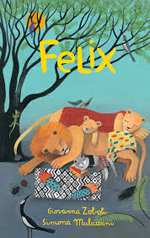 Felix, a domestic grey cat, travels around the world visiting members of the cat family in this whimsical Italian import. He plays with tigers in India, has tea with snow leopards in China, eats blinis with a lynx in Russia and a steak with a puma in a desert of the western U.S., learns how to be a night prowler from a panther in a Brazilian rain forest, and naps with lions in the African savannah. Simona Mulazzani’s portraits of the anthropomorphized cats in their natural environments offer readers a visual around-the-world tour.
Felix, a domestic grey cat, travels around the world visiting members of the cat family in this whimsical Italian import. He plays with tigers in India, has tea with snow leopards in China, eats blinis with a lynx in Russia and a steak with a puma in a desert of the western U.S., learns how to be a night prowler from a panther in a Brazilian rain forest, and naps with lions in the African savannah. Simona Mulazzani’s portraits of the anthropomorphized cats in their natural environments offer readers a visual around-the-world tour.
—LC
The Fishing Lesson. Heinrich Böll. Adapt. Bernard Friot. Ill. Emile Bravo. 2018. Eerdmans.
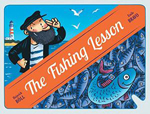 In this adaptation of a story by German author Heinrich Böll (1917–1985), a fisherman napping in his small boat in a coastal harbor is woken by the click, click, click of a tourist’s camera. In a series of colorful multi-panel and full-page illustrations by the French comic artist Emile Bravo, the tourist proceeds to explain to the fisherman how he could expand his fishing business to include multiple vessels, a smokehouse, and even a seafood restaurant. All the while, the fisherman remains silent. When the tourist states that becoming rich and successful would allow him to nap in the sunshine of the harbor, the fisherman points out that is exactly what he was doing before the tourist woke him up! This story is a humorous and gentle lesson reminding readers that success can be defined in many different ways.
In this adaptation of a story by German author Heinrich Böll (1917–1985), a fisherman napping in his small boat in a coastal harbor is woken by the click, click, click of a tourist’s camera. In a series of colorful multi-panel and full-page illustrations by the French comic artist Emile Bravo, the tourist proceeds to explain to the fisherman how he could expand his fishing business to include multiple vessels, a smokehouse, and even a seafood restaurant. All the while, the fisherman remains silent. When the tourist states that becoming rich and successful would allow him to nap in the sunshine of the harbor, the fisherman points out that is exactly what he was doing before the tourist woke him up! This story is a humorous and gentle lesson reminding readers that success can be defined in many different ways.
—LC
How to Knit a Monster. Annemarie van Haeringen. 2018. Clarion/Houghton Mifflin Harcourt.
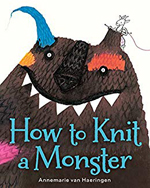 In this charming tale originally published in the Netherlands, Greta, a goat who is a talented knitter, must use her extraordinary skills and quick thinking to solve a problem that gets bigger and bigger the more she knits. When Mrs. Sheep insults her knitting skills, Greta becomes distracted, loses track of her knitting, and accidentally knits a wolf. When the wolf springs to life and gobbles up Mrs. Sheep, Greta must quickly knit a solution to save her. A humorous series of events unfolds as Greta knits larger and larger beasts to save Mrs. Sheep and herself. Using India ink, watercolor, and colored pencils, Annemarie van Haeringen effectively uses line drawings on primarily white backgrounds to keep readers’ attention on the foreground and Greta’s textured, intricately knitted creatures.
In this charming tale originally published in the Netherlands, Greta, a goat who is a talented knitter, must use her extraordinary skills and quick thinking to solve a problem that gets bigger and bigger the more she knits. When Mrs. Sheep insults her knitting skills, Greta becomes distracted, loses track of her knitting, and accidentally knits a wolf. When the wolf springs to life and gobbles up Mrs. Sheep, Greta must quickly knit a solution to save her. A humorous series of events unfolds as Greta knits larger and larger beasts to save Mrs. Sheep and herself. Using India ink, watercolor, and colored pencils, Annemarie van Haeringen effectively uses line drawings on primarily white backgrounds to keep readers’ attention on the foreground and Greta’s textured, intricately knitted creatures.
—LC
Koko and Bo. Lisen Adbåge. Trans. Annie Prime. 2018. Enchanted Lion.
 Originally published in Sweden, this picture book follows Koko and Bo (presumably Koko’s father, although not explicitly stated) as they navigate the young child’s stubborn exercise of independence by exclaiming “I DON’T WANT TO!” when asked to do something throughout the story. Although the story presents situations that may make some adults uncomfortable (such as Bo’s “Don’t then” response and departure following Koko’s refusal to leave after four hours at the playground), these events present opportunities to discuss parent–child relationships. The illustrations clearly express the emotions of Koko and Bo in their encounters as well as their love for each other. Additionally, Adbåge makes the illustrative decisions to depict Koko as gender neutral (the child is never identified as a boy or a girl in the text), and Bo, who is shown wearing brightly patterned clothing, is only identified as male by the use of the pronoun “his” at the end of the story.
Originally published in Sweden, this picture book follows Koko and Bo (presumably Koko’s father, although not explicitly stated) as they navigate the young child’s stubborn exercise of independence by exclaiming “I DON’T WANT TO!” when asked to do something throughout the story. Although the story presents situations that may make some adults uncomfortable (such as Bo’s “Don’t then” response and departure following Koko’s refusal to leave after four hours at the playground), these events present opportunities to discuss parent–child relationships. The illustrations clearly express the emotions of Koko and Bo in their encounters as well as their love for each other. Additionally, Adbåge makes the illustrative decisions to depict Koko as gender neutral (the child is never identified as a boy or a girl in the text), and Bo, who is shown wearing brightly patterned clothing, is only identified as male by the use of the pronoun “his” at the end of the story.
—LC
Little Bear’s Big House. Benjamin Chaud. 2018. Candlewick.
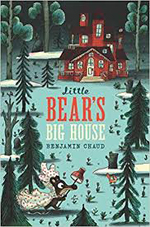 In early spring, restless Little Bear announces that he’s ready for a big adventure and sets out to explore far, far away from the forest. French author/illustrator Benjamin Chaud’s humorous, richly detailed artwork for this oversize book reveals Little Bear’s hurried movement through the forest and arrival at a charming red, multi-storied house in a clearing. Little Bears enters the unoccupied house and makes a big mess as he explores its many rooms happily singing “La, la, la-di-dum! Being on my own is so much fun!” until he hears a loud bang. Who’s in the house? Monsters? Ghosts? Discovering what sends Little Bear—and Mama, Papa, and Teeny Tiny Bear—running back to the forest makes this latest adventure of Little Bear as delightful as his earlier ones: The Bear’s Song (2013), Bear’s Sea Escape (2014), and The Bear’s Surprise (2015).
In early spring, restless Little Bear announces that he’s ready for a big adventure and sets out to explore far, far away from the forest. French author/illustrator Benjamin Chaud’s humorous, richly detailed artwork for this oversize book reveals Little Bear’s hurried movement through the forest and arrival at a charming red, multi-storied house in a clearing. Little Bears enters the unoccupied house and makes a big mess as he explores its many rooms happily singing “La, la, la-di-dum! Being on my own is so much fun!” until he hears a loud bang. Who’s in the house? Monsters? Ghosts? Discovering what sends Little Bear—and Mama, Papa, and Teeny Tiny Bear—running back to the forest makes this latest adventure of Little Bear as delightful as his earlier ones: The Bear’s Song (2013), Bear’s Sea Escape (2014), and The Bear’s Surprise (2015).
—CA
The Old Man. Sarah V. Dubois. Trans. Daniel Hahn. Ill. Claude K. Dubois. 2018. Gecko.
 As the people in town begin their day, it is also time for an old man to get up after a night on the streets. He’s cold; he’s hungry; he’s moved along by police officers. At the shelter where he hopes to get a meal, he must give his name but can’t remember it. As he huddles under his blanket in the park, he is noticed by a young girl who offers him her sandwich and tells him he looks like a teddy bear. That evening, the man returns to the shelter, and when asked for his name, he says, “Teddy.” The pencil sketches washed with a muted palette that match this quiet story, originally published in France, express the despair of the homeless old man and the difference a small act of kindness makes to him.
As the people in town begin their day, it is also time for an old man to get up after a night on the streets. He’s cold; he’s hungry; he’s moved along by police officers. At the shelter where he hopes to get a meal, he must give his name but can’t remember it. As he huddles under his blanket in the park, he is noticed by a young girl who offers him her sandwich and tells him he looks like a teddy bear. That evening, the man returns to the shelter, and when asked for his name, he says, “Teddy.” The pencil sketches washed with a muted palette that match this quiet story, originally published in France, express the despair of the homeless old man and the difference a small act of kindness makes to him.
—CA
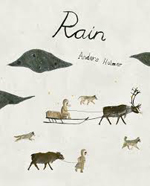 Rain. Anders Holmer. 2018. Eerdmans.
Rain. Anders Holmer. 2018. Eerdmans.
Twelve pairings of haiku and illustrations by Swedish author/illustrator Anders Holmer capture a series of short vignettes, each of them taking place in a differennt kind of rain, including a drizzle, downpour, thunderstorm, and even a shower of cherry blossom petals. The vivid imagery of the verses and the paintings (done in muted greys and brown with touches of color) invite reflection on nature and our relationship to it. For example, the verse “Beneath ashes are / seeds for a new forest that / might burn someday too” is visually portrayed in an exquisitely detailed painting showing a gentle rain extinguishing the last embers of a forest wildfire.
—CA
Sports Are Fantastic Fun! Ole Könnecke. Trans. Monika Smith. 2018. Gecko.
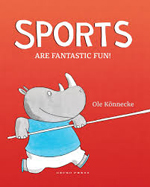 This informational picture book playfully depicts anthropomorphized animals participating in a wide range of sports—everything from golf to rugby to billiards. Each sport is individually highlighted, allowing readers to read as much or as little as they want to at one time. Readers of all ages can learn about different games and competitions (including some they may not know about such as French boules, caber toss, and slacklining) in this collection of sports played around the world. German author/illustrator Ole Könnecke’s humorous ink-and-watercolor spreads with a Richard Scarry-like layout of small blocks of text with basic information (and clever asides) and illustrations of animal athletes—alligators climbing a snowy alpine mountain, a giraffe pole vaulting, a flamingo performing a rhythmic gymnastics routine, and more—add to the fun of this engaging introduction to sports.
This informational picture book playfully depicts anthropomorphized animals participating in a wide range of sports—everything from golf to rugby to billiards. Each sport is individually highlighted, allowing readers to read as much or as little as they want to at one time. Readers of all ages can learn about different games and competitions (including some they may not know about such as French boules, caber toss, and slacklining) in this collection of sports played around the world. German author/illustrator Ole Könnecke’s humorous ink-and-watercolor spreads with a Richard Scarry-like layout of small blocks of text with basic information (and clever asides) and illustrations of animal athletes—alligators climbing a snowy alpine mountain, a giraffe pole vaulting, a flamingo performing a rhythmic gymnastics routine, and more—add to the fun of this engaging introduction to sports.
—LC
The Visitor. Antje Damm.Trans. Sally-Ann Spencer.2018. Gecko.
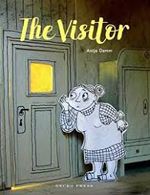 German author/illustrator Antje Damm uses intriguing illustrations, created with cutout figures posed against dioramas, to tell the story of a visit made by a boy to a reclusive woman that brings color to her life. One day, when Elise opens a window to let fresh air into her tidy but colorless room, a strange blue thing made of paper flies in. In the morning, when she responds to a persistent knocking, she finds a small boy at the door. “I’m here for my plane,” he says, and then asks to use her bathroom. “It’s urgent!” As the boy moves through the house, bright colors are added to all the things he sees and asks about. By the time the boy waves goodbye after spending the day, even the once white image of Elise is touched with pink as she adds, “Bye for now, Emil.”
German author/illustrator Antje Damm uses intriguing illustrations, created with cutout figures posed against dioramas, to tell the story of a visit made by a boy to a reclusive woman that brings color to her life. One day, when Elise opens a window to let fresh air into her tidy but colorless room, a strange blue thing made of paper flies in. In the morning, when she responds to a persistent knocking, she finds a small boy at the door. “I’m here for my plane,” he says, and then asks to use her bathroom. “It’s urgent!” As the boy moves through the house, bright colors are added to all the things he sees and asks about. By the time the boy waves goodbye after spending the day, even the once white image of Elise is touched with pink as she adds, “Bye for now, Emil.”
—CA
The Wolf Who Visited the Land of Fairy Tales. Orianne Lallemand. Ill. Éléonore Thuillier. 2018. Auzou.
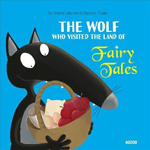 Wolf wants to bake an apple cake for the annual Spring Tea Party and sets out to find a recipe and gather ingredients. Although plagued by the “big bad wolf” stereotype, he succeeds in getting Aunt Rosie’s recipe from the three little pigs after helping them build their houses, and borrows needed ingredients (flour, butter, eggs, sugar, and apples) from various characters in the Land of Fairy Tales. Following Aunt Rosie’s recipe, Wolf arrives at the party with a perfectly baked apple cake and some new friends, including the Three Little Pigs, Little Red Riding Hood, the Little Red Hen, and Snow White. Wolf, who is featured as a long nosed, big eyed, toothy, charming, and not-at-all-bad wolf in the colorful cartoon-style illustrations, is a popular character in The Wolf Who . . . series in France.
Wolf wants to bake an apple cake for the annual Spring Tea Party and sets out to find a recipe and gather ingredients. Although plagued by the “big bad wolf” stereotype, he succeeds in getting Aunt Rosie’s recipe from the three little pigs after helping them build their houses, and borrows needed ingredients (flour, butter, eggs, sugar, and apples) from various characters in the Land of Fairy Tales. Following Aunt Rosie’s recipe, Wolf arrives at the party with a perfectly baked apple cake and some new friends, including the Three Little Pigs, Little Red Riding Hood, the Little Red Hen, and Snow White. Wolf, who is featured as a long nosed, big eyed, toothy, charming, and not-at-all-bad wolf in the colorful cartoon-style illustrations, is a popular character in The Wolf Who . . . series in France.
—CA
Wolfy. Grégoire Solotareff. Trans. Daniel Hahn. 2018. Gecko.
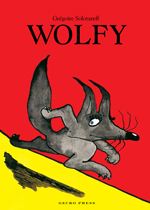 Wolfy (a young wolf) and Tom (a rabbit) develop an unconventional friendship, but when a game of Who’s Afraid of the Big Bad Wolf becomes too frightening for Tom, he refuses to leave his burrow and does not want to see Wolfy again despite Wolfy’s attempt to apologize. After having his own scary encounter with a pack of wolves, Wolfy truly understands how scared he made Tom feel and the two patch up their friendship. French author/illustrator Grégoire Solotareff uses bold black lines and large blocks of bright primary colors for dramatic effect in this story of the ups and downs of friendship. Wolfy is the first translation into English of Solotareff’s popular classic picture book Loulou, first published in France in 1989.
Wolfy (a young wolf) and Tom (a rabbit) develop an unconventional friendship, but when a game of Who’s Afraid of the Big Bad Wolf becomes too frightening for Tom, he refuses to leave his burrow and does not want to see Wolfy again despite Wolfy’s attempt to apologize. After having his own scary encounter with a pack of wolves, Wolfy truly understands how scared he made Tom feel and the two patch up their friendship. French author/illustrator Grégoire Solotareff uses bold black lines and large blocks of bright primary colors for dramatic effect in this story of the ups and downs of friendship. Wolfy is the first translation into English of Solotareff’s popular classic picture book Loulou, first published in France in 1989.
—LC
Laura Cutler is a Ph.D. student in the Department of Human Development and Family Sciences at the University of Delaware. Carolyn Angus is former director of the George G. Stone Center for Children's Books, Claremont Graduate University, in Claremont, California.
These reviews are submitted by members of the International Literacy Association's Children's Literature and Reading Special Interest Group (CL/R SIG) and are published weekly on Literacy Daily.